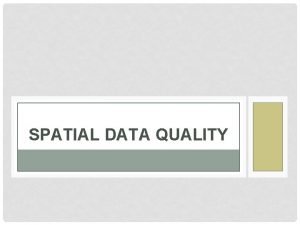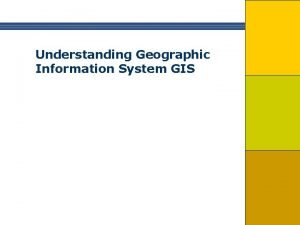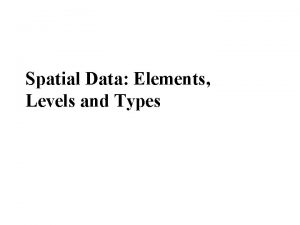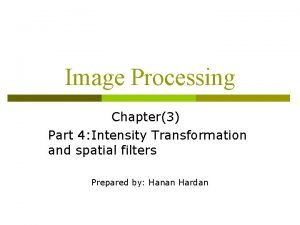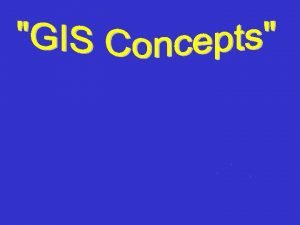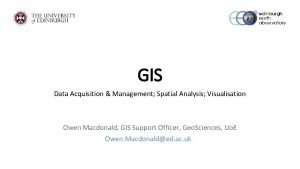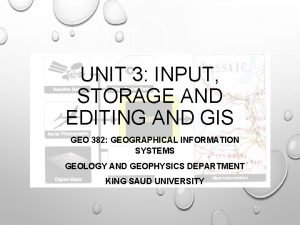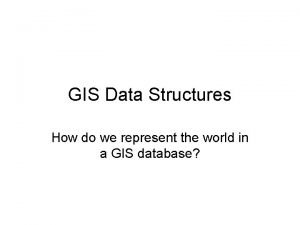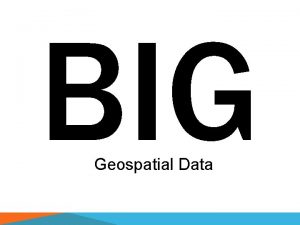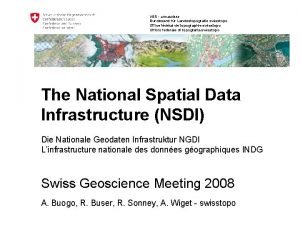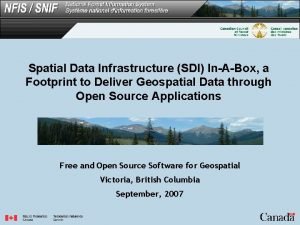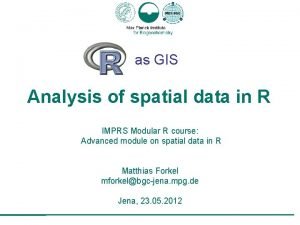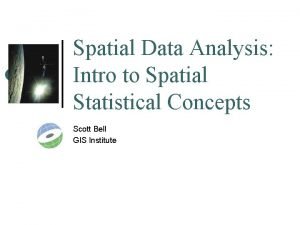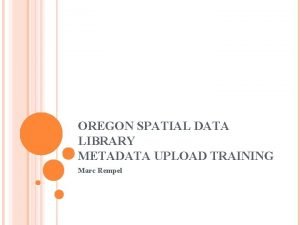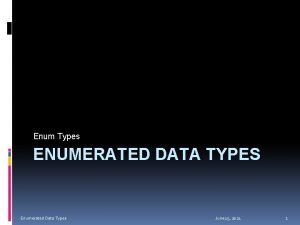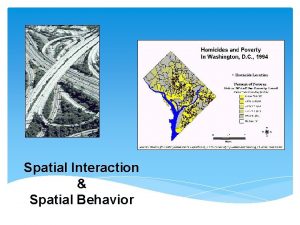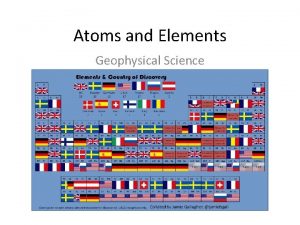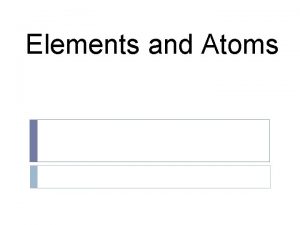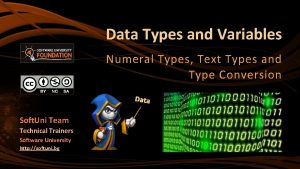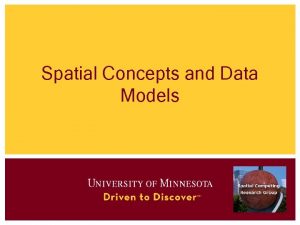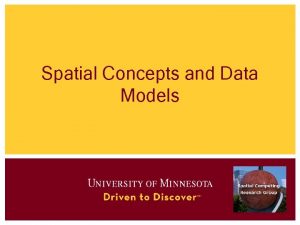Spatial Data Elements Levels and Types Spatial Data























- Slides: 23

Spatial Data: Elements, Levels and Types

Spatial Data: What GIS Uses Bigfoot Sightings: Spatial Data

A GIS Provides the Ability to Analyze Disparate Data Sets Based on Location

Spatial and Attribute Data § Spatial data (where) l specifies location § Attribute data (what) l l specifies what is at that location stored in a database table § A GIS will link spatial and attribute data for display or analysis

Spatial Elements 4 Types of Phenomena

Points 1 2 3 4 § Points occur at one location in space. § Examples include houses, trees etc. § Discrete or fixed: Occupies one space at any time. § Moving: Examples include, cars, fish, deer § They have no spatial dimension.

Lines § Occupy a single dimension. § Examples include: roads, boundaries, and networks. § Do not have a width, but length can be measured.

Area 3 1 2 § § § 2 -dimensional objects Length and width can be measured Surfaces, which include two types: Discrete, has a definite boundary ex: towns Continuous, has a changing boundary ex: meandering river

Volume § 3 -dimensional. § Examples include the volume of water in a lake, air masses. § Continuous data includes: elevation, rainfall, ocean salinity § Moving data includes: air masses, animal herds, schools of fish


GIS Attempts to Describe All Features in Geometric Terms. § Points: surveyed locations, new construction, community resources § Lines: roads, transit routes § Areas: parcel maps, zip codes, census tracts

Data Types - 4 Types § nominal • no inherent ordering • land use types, county names • yes or no data § ordinal • • inherent order road class; stream class hierarchy can be compared § interval • known distance between values • no natural zero • can be compared § ratio • natural zero • ratios make sense (e. g. twice as much) • income, age, rainfall

Data Types

GIS Links Spatial Data with Attribute Data for a Feature on a Map The information is stored as ‘attributes’ of the graphically represented feature. Roads Map Feature List Attribute Table 4 6 1 2 3 5 Example: A line that denotes a road shows its location. An attribute table stores all relevant information about this feature, which can be queried and displayed in a format based on the user’s needs

There are Two Ways to Acquire Spatial Data to Put Into a GIS 1. You purchase, or are given an existing data set 2. You go out and collect the data yourself

Major GIS Data Sources § § § § Maps Drawings (sketch or engineering) Aerial (or other) Photographs Satellite Imagery/Digital Ortho Photography CAD data bases Government & commercial spatial (GIS) data bases Government & commercial attribute data bases Paper records and documents

Where do we get the data? § Purchase the data already processed and ready to use. § Purchase the data and then complete the processing. § Get original data in office or lab. § Get original data in the field.

Existing Data § Purchase satellite images/ aerial photography already processed § Find public domain sources of images. Or share costs with data partners. § Purchase or download data and process inhouse.

Existing Data § We may purchase or share an attribute data base (Excel spreadsheet, or Access database). § Must have a spatial component. § Sometimes we must “clean” the data.

Data Collection § § Compile data directly from air-photos. Digitize from existing paper maps Scan from existing maps Field data collection. Hand-held, mobile and airborne GPS (Global Positioning Systems).

Creating your own data Most GIS users still must create their own data or need to update it Manual Digitizing Raster Scanning

Pre-processing and Conversion: usually required! § Maps and Drawings l l digitizing, or scanning § GIS Data Bases l § Aerial Photographs l l photogrametry/photo interpretation to extract features digitizing or scanning to convert to digital § Satellite Imagery/ Digital Orthophotography l rectification and DEM (digital elevation model) § CAD Data Bases l translator software (pre-existing or custom-written) needed to convert to required GIS format l conversion between proprietary standards (ARC/INFO, Intergraph, GDS, etc. ) Spatial Data Transfer Standard § Attribute Databases l l geocoding if micro data conversion between geographic units § Records and Documents l l l OCR (optical character recognition) scanning keyboarding then, same as attribute data bases

Representation of space elements. . . A 1 S 1 P 1 A 3 S 2 P 3 A 4 P 4 A 8 Human Perception P 2 A 6 P 5 A 5 S 4 P 7 P 8 P 9 A 11 S 3 P 6 A 7 P 10 P 11 A 12 Arc-ID Nœud_F 1 1 1 2 2 5 3 4. . . 3 5 3 4 Computer Perception S 6 S 5 P 12 A 13 Arc-ID (X, Y) 1 2 3 4. . . (a, b) , . . . , (a, b) (c, d) , . . . , (e, f) (g, h), . . . , (g, h) (e, f) , . . . , (g, h) Spatial Data. Base
 Spatial data vs non spatial data
Spatial data vs non spatial data Elements of spatial data quality
Elements of spatial data quality Spatial data and attribute data
Spatial data and attribute data Spatial data and attribute data
Spatial data and attribute data Costa's level 2 question examples
Costa's level 2 question examples Carbon group periodic table
Carbon group periodic table Types of spatial filtering in digital image processing
Types of spatial filtering in digital image processing Overhead allocation
Overhead allocation Les 4 types de manager
Les 4 types de manager Spatial data mining applications
Spatial data mining applications Spatial data acquisition
Spatial data acquisition Components of gis
Components of gis Spatial data acquisition
Spatial data acquisition Big spatial data
Big spatial data Gis data input
Gis data input Spatial big data platform
Spatial big data platform Spatial data structures in gis
Spatial data structures in gis Spatial data transformation
Spatial data transformation Big data spatial
Big data spatial Swiss vbs
Swiss vbs National spatial data infrastructure
National spatial data infrastructure Applied spatial data analysis with r
Applied spatial data analysis with r What is spatial data?
What is spatial data? Oregon geospatial data library
Oregon geospatial data library

